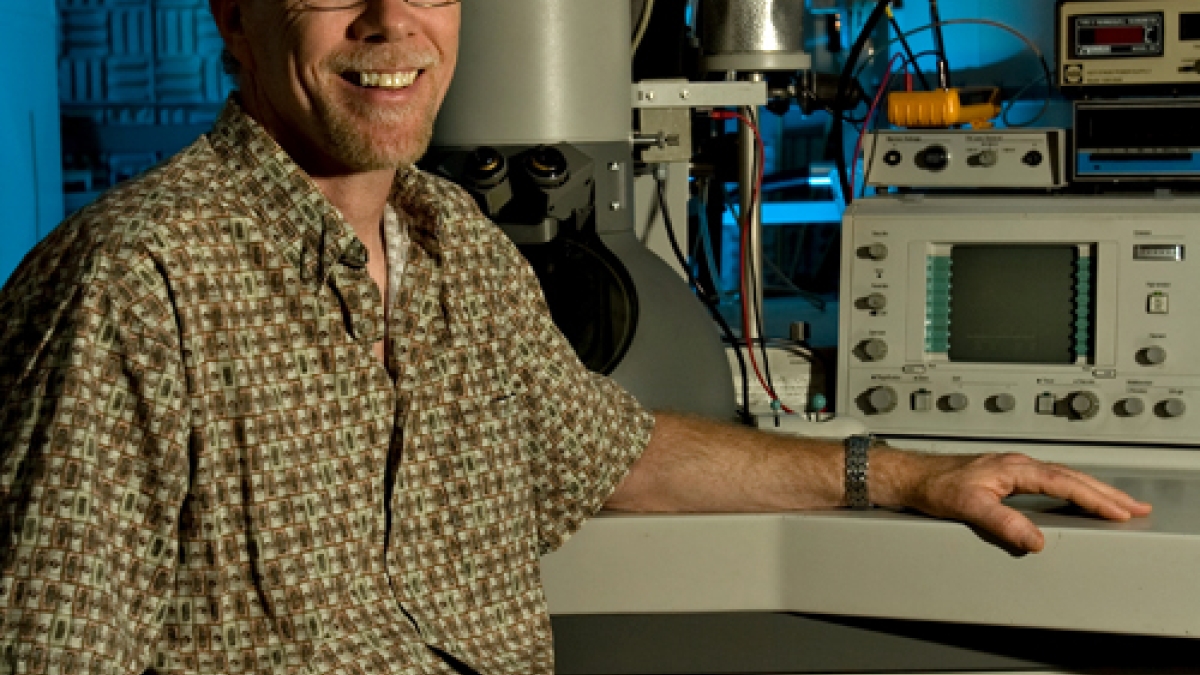Center director sets sharp focus on collaborative research

“You can’t go home again,” wrote Thomas Wolfe, but Thomas Sharp, a professor at ASU, feels differently.
As the director of ASU’s LeRoy Eyring Center for Solid State Science, Sharp now leads the facility that played an integral role in his graduate education and his continuing research as an ASU professor. His top priority is to preserve the world class environment for advanced materials research and training that has defined the LeRoy Eyring Center for four decades.
“I intend to keep the center strong by maintaining cutting edge facilities and techniques for the characterization of solids. It’s crucial to preserve the strong research profile of the center around the world and within ASU,” said Sharp, who became director in July.
Formed in 1974, the center houses one of the country’s most comprehensive collections of high-end tools for the characterization of solid materials. It supports materials research activities across a broad range of disciplines, including solid-state physics and chemistry; Earth and planetary science; materials science and engineering; life sciences; electrical engineering.
In subscribing to ASU’s mission of “Quality and Access to All,” the center’s instruments and expertise are made available to researchers not just within ASU but across an expanding industrial community, ranging from local startups to Fortune 50 multinationals whose names are synonymous with innovation and quality.
Sharp arrived at ASU in 1983 as a graduate student with a focus on mineralogy and petrology, with a strong interest in mineral reactions in rocks. He received a master’s degree in geology in 1983 and a doctoral degree in geology in 1990 from ASU. He joined the ASU faculty as an assistant professor in 1997 and is now a full professor in ASU’s School of Earth and Space Exploration and ASU Associate Director of NASA’s Arizona Space Grant Consortium.
“As a mineralogist, I’m intensely interested in the reactions, transitions and deformation of minerals that occur deep in the Earth, on planetary surfaces and in shocked meteorites,” Sharp said. “We’re applying what we’ve learned to understanding the dynamics of Earth’s mantle, collisions in the asteroid belt and chemical weathering on the surface of Mars.”
Closer to home, Sharp directs the NASA Space Grant Program at ASU. Space Grant provides undergraduate internships and graduate fellowships for ASU students to participate in NASA related research and outreach.
Sharp does much of his research through the careful analysis of rocks and minerals using an array of electron microscopes and other instruments contained in the LeRoy Eyring Center.
“Having sophisticated tools and analytical techniques available with open access and hands-on training was a huge asset to my career and my research at ASU. This has also been the case for many researchers around the world, in academia and in industry, who have worked in solid state science at ASU,” said Sharp.
Following his postdoctoral research at ASU, Sharp had an opportunity to establish a transmission electron microscopy lab in Germany, and joined the Bavarian Research Institute of Experimental Geochemistry and Geophysics. Sharp credits this opportunity to the training he received at ASU and the international reputation for excellence in microscopy enjoyed by ASU and the LeRoy Eyring Center.
“Unlike most other laboratory environments, the center has been committed to sharing our expertise with researchers, and it’s been doing this for 38 years,” Sharp said. “As a result, we’ve become a de facto training center for generations of scientists – and this capability is recognized in research environments around the world. ASU’s reputation in electron microscopy was a key factor in my being hired to establish a lab at the Bavarian Geoinstitute.”
This legacy of excellence led the LeRoy Eyring Center to acquire two aberration corrected electron microscopes for what is expect to become cutting-edge research at the atomic scale. These world class instruments will be housed in a custom-designed building that is considered among the world’s “quietest” environments for electron microscopy.
When Sharp is not directing the LeRoy Eyring Center or his research program, he can often be found interacting with the natural environment that has formed the basis of interest in geology. One of his favorite courses to teach is Field Geology II, an upper division course for geology undergraduates in the School of Earth and Space Exploration in ASU’s College of Liberal Arts and Sciences.
“Observing, recording and interpreting complex geology in the field is a very challenging and rewarding activity that requires great focus. I get a similar sense of exploration when I examine a mineral sample at the atomic scale in a transmission electron microscope,” Sharp said.
“These activities are great,” Sharp confessed, “but nothing beats the pure enjoyment of hiking, mountain biking and camping with my family.”
Jeff Luth, jeff.luth@asu.edu
480-727-8578
LeRoy Eying Center for Solid State Science